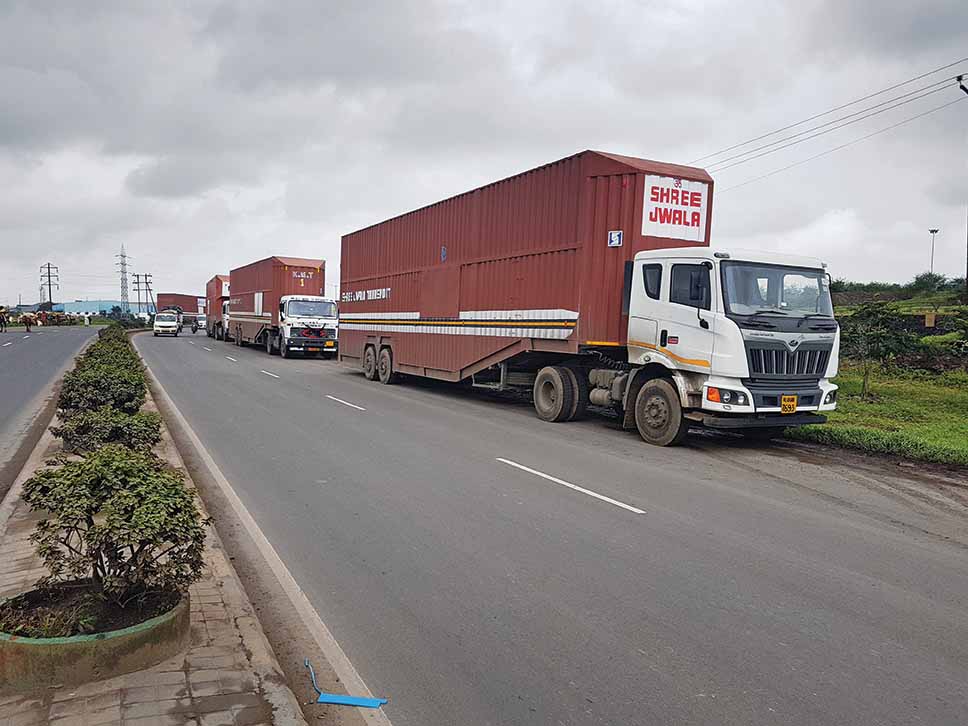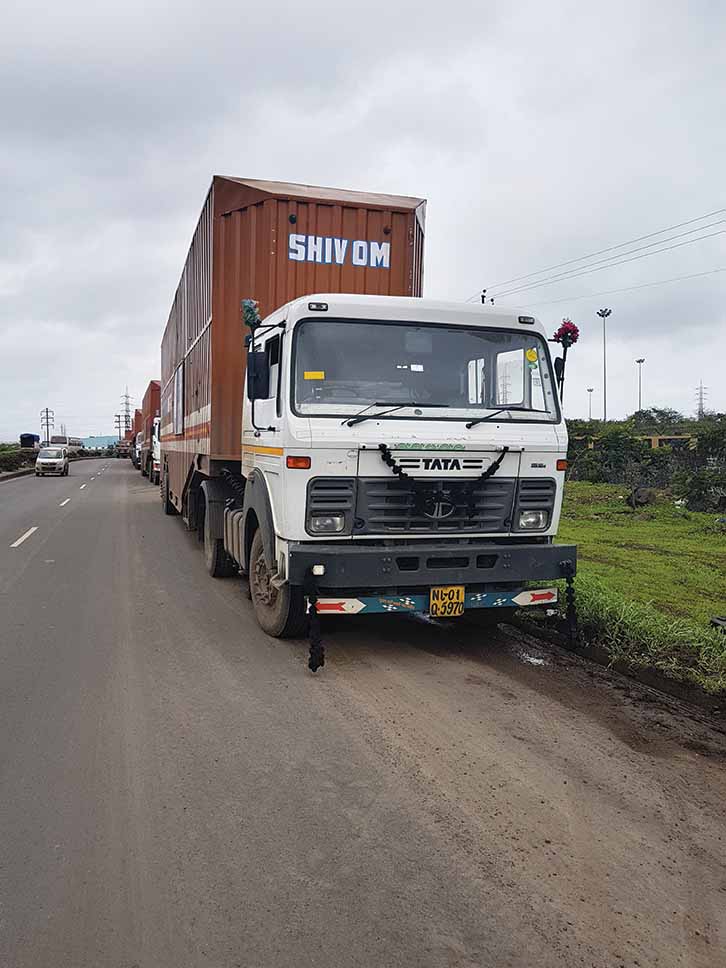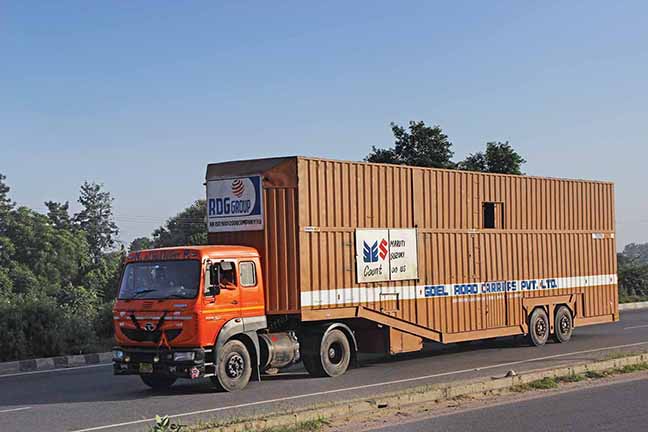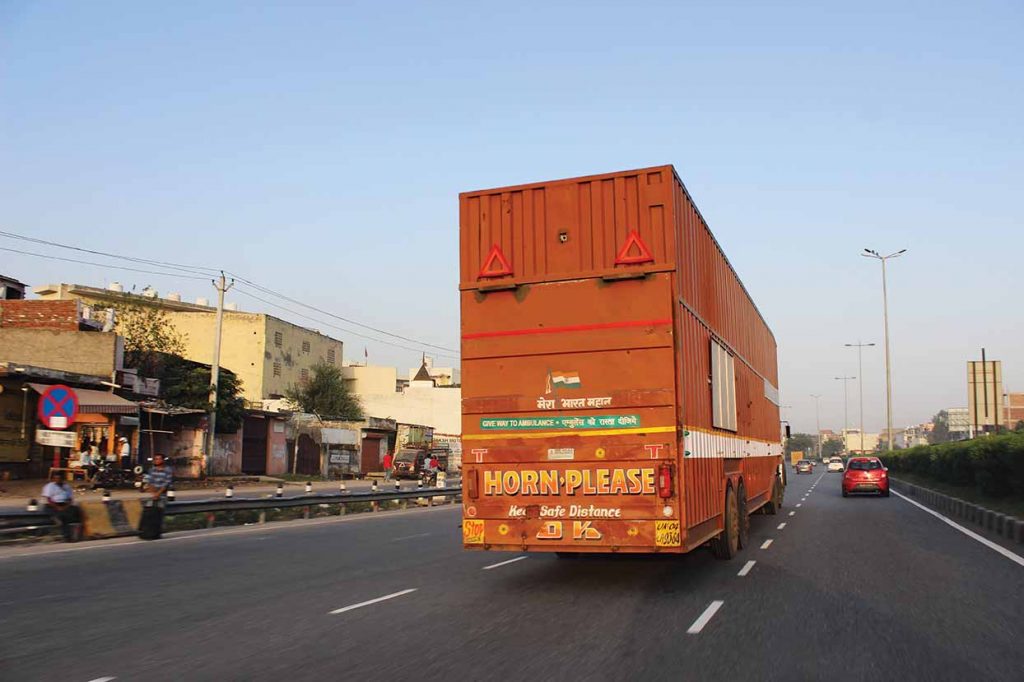Facilitating the carriage of cars, the car carrier industry is playing a key role in the logistics sector.
Story by:
Gunjan D Bidani & Sukhpreet Singh
Rakesh does not look the part. His slight build defies his age. He says he is 30 years old but looks younger. Driving a long vehicle that a car carrier is termed a, Rakesh is waiting to ferry a truck load of Hyundai cars at the Hyundai plant in Sriperumbudur. He is eagerly waiting to embark on a journey that will take him to Delhi NCR, roughly 2,300 kms away. Expecting to be on the road for a good part of the week in his Kohima-license plate carrier that measures 18.75 ft. in length, Rakesh revealed that he could carry up to eight cars or five SUVs. Hoping to leave as early as possible so that he can make it in time to deliver the vehicles to the dealer stockyard, Rakesh works for a Chennai-based car carrier company, which in-turn caters to Hyundai Glovis (India). Leading a life that is not easy, Rakesh will be on the road for long hours at the wheel of his truck. He will stay at dhabas in the absence of good lodging facilities. Away from his family at months on end, Rakesh is part of the car carrier industry, which operates no less than 15,000 trailers, and transports three million cars across India. Consisting of big players that operate a fleet of 700 to 800 car carriers, and of small players that operate 50 to 70 car carriers, the industry does business worth Rs.5.25 million approximately.
A small yet organised industry, according to Vipul Nanda, President, Car Carrier Association of India, and Chairman and Managing Director, Mercurio Pallia Logistics, there are about 100 players in the fray, and involve different stakeholders. A part of the burgeoning logistics sector worth USD 160 billion, and often underrated, the car carrier industry in India transports cars that cost anywhere between Rupees-two-and-a-half-lakh to a few crores. Often compelled to work in conditions that are far from ideal, the cars the industry ferries are of substantial value. If this makes its task particularly important and risky, the fact that only five per cent of the vehicles in India are transported by rail should provide a good idea of what the car carrier industry does. For an industry that sold 3.3 million cars in FY2017-18, and is expected to touch six million units by 2020, the car carrier industry amounts to a vital link. According to Aman Kapoor, Senior Analyst, Automotive, IHS Markit, the operational growth of the car carrier industry is directly proportional to the Light Vehicle (LV) ouput in the country. As more and more vehicle brands enter India along with a fast paced product launch cycle, the ripple effect of it will stimulate demand for car carriers. Claimed to be transparent in its ways of working, the car carrier industry adheres to standard delivery time-lines. This is made challenging when the trailers, for the lack of space at the stock yard get stranded.
With the transit time standard across the board, 90 per cent of the times, the damage to the cargo is less than two per cent, informed Nanda. To curb damage to the cargo, each car carrier has high quality lashing systems, he mentioned. The entire wheel is lashed to the perforated floor of the trailer, which greatly reduces the risk of damage. Moving at reatively slow speeds, which minimises any chance of getting involved in a crash, the most chance of damage to the cargo is during loading and unloading of cars. Fitted with GPS tracking systems for security, and in-line with the requirements of the OEMs, the car carrier industry has come to collect a good amount of data. With the entry of new car brands like Kia and MG expected to influence an increase in business, the car carrier industry is only poised to do more business. It is also well-positioned to gather more data. The challenge however is in dissementing it, and to take corrective measures. Leveraging IT to build technologies that are useful, the car carrier industry, with the participation of global players like Hyundai Glovis and Mercurio Pallia, is set to adopt new practices and gun for higher efficiency. Facing the challenge of infrastructure and manpower, it is benefitting from the participation of leading global trailer manufacturers and market leaders like Lohr. Looking at a positive change, the car carrier industry, said Aman, is carriers occupying a substantial per centage of the medium and heavy commercial vehicle sales. He drew attention to the trend for car carriers showing an upward growth. Not only will the car carrier industry perform, it will exist as long as there will be passenger vehicles,” he added.
Expected to witness the participation of new players as the car parc in the country grows, the car carrier industry may soon witness a change in its current structure. The current structure of the industry involves an estimated 13,000 to 14,7000 trailers and 3,000 to 4,000 rigid truck carriers. Procuring purpose-built trailers (that comply with the car carrier reguations set by the government) from Pune, Gurugram and Bengaluru among few other places, many car carrier fleets are facing the challenge of funding. According to Nanda, there are various cost heads involved, and the business is investment intensive as well as asset-heavy. Revealing that automotive OEMs for which the car carrier industry works, help them financially, Nanda expressed that the infrastructure for trailers is poor. There are unorganised players, which provide trailers at a lower cost, he informed. “The trailers that international players like Lohr cost significantly higher,” he explained.
Found in the Delhi NCR region in good numbers, perhaps due to the higher density of automotive plants in the region, the car carrier industry functions in ways that could differ widely. It could amount to an evolution, though too early to say. Averred Nanda, “The design of the trailers is unaffected, and not much resources have been allocated for research and development.” Drawing attention to the way the industry functions, Nanda said that some players quote Rs.10 lakhs for the same assignment where others quote Rs.20 lakhs. “This makes it tough as no OEM will pay extra for carrying the same load. With cost the most important factor, the quality of the asset body remains unaffected,” he added. Said to be a slow evolving industry globally, the one in India is seeking better wages from its clients. It is also looking at a ‘priority’ treatment.
Facing the challenge of road infrastructre, easy inter-state movement and realtime tracking in order to synchronise the entire journey from start to end, the car carrier industry, according to Aman, is better regulated than it was earlier. Tracing its origin to the arrival of new generation cars in the early 80s, the car carrier industry is today functioning as per the set of guidelines that assure safety and operational efficiency. Of the opinion that regulatory measures from the government (and related bodies) are setting things straight and offer a organised way for the car carrier industry to function in the future, Aman called for a need to address the grey areas. “Doing that will help scale up penetration in order to build a sustained environment,” he said. Forming an association of car carrier operators in the wake of the steps the government took to regulate it, Nanda revealed, that they wrote to the Central Government to implement car carrier rules. “Our suggestion was positively looked upon, and acted. The Goverment called us for a discussion. A high level committee was appointed with an IIT professor, Anoop Chawla, as the head. He observed that there were trailers that measured 22, 23 and 24 ft. in length whereas internationally the limit was set at 18.75 ft. The government framed rules, and post which, the existing trailers were downsized to 18.75 ft. in six months,” said Nanda. Stating that the industry set an example by doing so, Nanda mentioned, “As a result, the payload capacity and the ability of car carriers to carry cars has come down. The change, vital in the interest of safety, led us to charge OEMs on a per car rate. We were met with protests. Taking note of the situation, Maruti Suzuki supported us. The negotiations that followed, put us back into the business.”
Despite the new regulations granting a legal status to complying car trailers, challenges as they travel through states continue to exist. Car carriers continue to be fined by state authorities, according to Nanda. “Things haven’t changed till now, and we contribute to the state revenue. We are requesting the Government to look into this and have even filed a court case in the Rajasthan High Court,” he revealed. Giving an example of a truck travelling from Delhi to Chennai coughing Rs.10,000 in fines without any details, Nanda mentioned that the varying fine amounts is wierd. In Maharashtra, it could be Rs.2000. In Rajasthan, it could be Rs.5000, and in Gujarat, it could be Rs.3000, he stated. Shortage of drivers is another challenge the car carrier industry continues to face. Influenced by the ups and downs in car sales, the car carrier industry is often at the mercy of festivals. A change in pattern is a given with festivals like Onam increasing the demand for cars in South India. Striving to ensure that the drivers of their vehicles can lead a respectable life, car carrier fleet owners, through their association and on their own are taking effort. Truck drivers, said Nanda, want to educate their children so that they do not venture in the profession that they are in. This is because of the low rewards, he added.
To elevate respect and make it attractive for new people to venture in, car carrier companies are beginning to conduct various welfare programmes for their drivers, and driver families. They are giving scholarships to the children of the drivers. Some companies are going to the extent of entering into a tie-up with petroleum companies, local transport hub bodies, CV OEMs to ensure that their drivers are able to avail of good lodging facilities whenever they are on the road. Hoping that the shortage of truck drivers will soon be a thing of the past, the car carrier industry is grappling with over capacity as turnaround times decrease. The implementation of GST, and the improvement in infrastructure have created an environment where the car carrier industry is gaining from faster turnaround time and the e-way bill. The trouble is, said Nanda, the humongous penalty on e-way bill even if there is a small mistake. “We were fined Rupees-one crore recently,” said Nanda. “Gati had to pay Rs.1.32 crore for a mistake in the e-way bill,” he added.
Of the opinion that operating companies should not be fined if the mistake is not deliberate, Nanda stated that GST will take time to settle down. “The good part is, we can now take input credit. In terms of warehousing, we have not seen a drastic change. Taxation hasn’t changed. There were a number of taxes earlier. Now there is a single tax to be paid,” said Nanda. Drawing attention to car carrier operators seeking new generation tractors and trailers, which offer higher utility value, he averred, that there is good potential in the two-wheeler carrier portion of the industry. “About 40 per cent of the two-wheeler carriage needs are yet to be fulfilled,” he added. In the area of tractor carriers, Nanda commented that the use of double decker trailers over broad trailers is rising. Anticipating railways to play an increasingly bigger role in the carriage of autos in the next three years once a dedicated freight corridor is in place, Nanda opined that first mile and last mile will still be serviced by car carrier operators. “This will continue till a way is found out to lay a rail line to the plant and the stock yard,” he said.
Transporting 93 per cent of the cars, the car carrier industry in India is keen to cut down on idle time that is accounted for during loading and unloading prominently. It is also keen to cover 6000 km over the current 4500 to 5000 km, and is eyeing a secure future for itself. Looking at elminating some of the risks that are built into the business model where each trailer costs Rs.35 lakhs on an average, the car carrier industry is looking at big gains in efficiency and productivity. Striving to eliminate risks, where the cost of assets is significant, and the risk of going belly up is always high, the car carrier industry is looking at a sustainable future. It is hoping that the OEMs understand this sooner than later. Expressed Nanda, that an ilding truck costs Rs.3000 a day. The average loss is Rs.50 per km. If the truck would cover a distance of 1500 km, it would amount to Rs.7,500. Expected to consolidate, and even re-orient itself, the car carrier industry is loking at a brighter future.
Read http://commercialvehicle.in/the-future-of-the-indian-cv-industry/

























